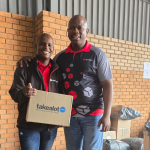Have you ever wondered why dung beetles don’t get lost, even when they navigate vast expanses backwards?
A research team led by Marie Dacke, professor of Sensory Biology at Lund University and renowned biology researcher and Professor Marcus Byrne from Wits asked and answered this question. Their discovery of how the dung beetles’ wind compass complements the sun compass, rolls on some fundamental lessons for better data prioritisation and navigation.
PATH FOR MACHINE LEARNING
Dung beetles have a fall-back system of compass cues that they can switch between, dependent on which one is providing the most reliable information for orientation, says Professor Byrne, who has collaborated with Dacke for almost 20 years on dung beetle orientation.
“This is the first study that shows how an animal’s biological compass can integrate different directional sensors, in this case wind and sun, in a flexible way. This enables the highest possible precision at all times,” says Dacke.
When it is cloudy, or when the sun is higher than 75 degrees above the horizon in the middle of the day, dung beetles are unable to use the sun as a directional guide. A couple of hours later, when the sun is a little lower, they tum off the wind compass and again rely on the sun to navigate.
The aim of the research is to understand how very small brains handle large amounts of information in order to make a relevant decision: is it appropriate to turn left or right, or continue straight on?
Byrne Illustrates this point, saying “choosing the most important job at any given moment is a task most computers struggle with, which we all know about from the frustration of attempting to send an email while our machine checks its virus protection.”
Dacke believes that the results will be of direct benefit within a few years, in areas like robot development and Artificial Intelligence (Al). Just like dung beetles, robots must take large amounts of information into consideration in order to direct their next action.
NAVIGATING ORIENTATION UNDERSTANDING
The researchers investigated dung beetles in the field and in the laboratory. Using fans to create and manipulate wind direction, they examined how wind direction affects the insects’ directional awareness. This was also done with the sun, by artificially changing its position with a mirror.
The results show that directional information can be transferred from the wind compass to the sun compass and vice versa. In this way, the dung beetles can track their course when one of the compasses becomes less reliable.
“The insects’ brains are definitely not pre-programmed to always follow the same set of actions. We can show that such small brains work according to very dynamic principles that adapt to the conditions prevailing at a given moment,” says Dacke.
The researchers had previously shown that, during the night, some dung beetles orientate by the Milky Way and polarised moonlight while rolling their dung balls in a straight line. Combining the results of their study with the results from the Milky Way study, they show that the insects’ compass works at all times of the day or night – and probably under almost any conditions.
LEADING MACHINE LEARNING
Wits is pushing far into the future in many ways through its Postgraduate Programmes in Machine Learning, AI and Robotics. One of its recent moves saw the Wits School of Chemistry launching a new AI research initiative for Africa. Hosted by the Molecular Sciences Institute (MSI) in the School of Chemistry, the newly formed Cirrus Initiative will focus on the analysis of research data in chemistry, with a view to collaborating with physics, technology and engineering projects, using machine learning.
Cirrus aims to create a collaborative university and industry platform supporting an African ecosystem that fosters innovation and entrepreneurship. As the host university, Wits will lead the Cirrus Initiative’s cooperation efforts with universities, institutes, centres of excellence and research groups in Africa.
Join one of the leading teams of researchers at Wits University and position yourself at the top of modern science and technology. A postgraduate degree in these fields will provide you with the skills to work where there is a huge demand and a shortage of skills, as well as pioneering the use of new technology to make meaningful advances in all areas of society. DM
For more information about the world-changing future work you can conduct at Wits, go to www.wits.ac.za/machine-learning-ai-robotics/.


















 Become an Insider
Become an Insider